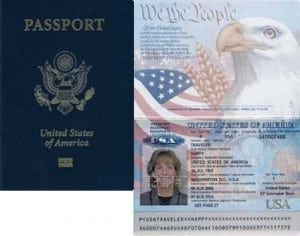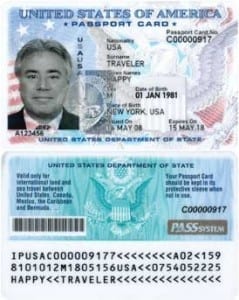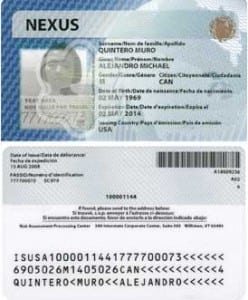The Different Types of Border Crossing Documentation
- Real ID
- Passport
- Passport Card
- Enhanced Driver License / Enhanced Identification Card
- Nexus
- Global Entry
- FAST
- VISA
- Canpass
- SENTRI
Real ID
The US will require a “Real-ID compliant document” when a US citizen boards any domestic flight after May 7, 2025. You will not be allowed to board your flight if you do not have a Real ID compliant document, but it is not required to cross the US and Canadian border. A Real ID is not a separate type of identification. It is any documentation that the US federal government considers to be highly secure and accurate. Typically, this will be your passport or a state issued enhanced driver’s license. You still need your passport if you are flying internationally. Below are the types of documents the US considers Real-ID compliant. This list may change over time:
- State-issued Enhanced Driver’s License: Your driver’s license or state ID card is REAL ID compliant if it has a star circled in gold printed in the upper right corner of your card, or if you have an enhanced driver’s license or state ID card that has a small American flag printed on it.
- Some states have different markings so you will need to check with your state’s licensing authority to confirm whether you have a Real ID compliant license.
- In order to get a Real ID compliant driver’s license, you will need to submit several pieces of identification when you apply for renewal, and you will need to make an in-person appointment at the DMV. When you get your renewal notice in the mail, it will state whether or not your license or state ID is REAL ID compliant.
- Passport
- Passport Card
- PIV or Federally-issued Personal Identification Verification – Interoperable (PIV-I) Cards
- Driver’s License issued by the U.S. Department of State
- Border Crossing Card (Form DSP-150)
- DHS “Trusted Traveler” Cards – Global Entry, Nexus, SENTRI, FAST
- U.S. Military ID: all members of the U.S. Armed Forces (including retirees and dependent ID card holders) and veterans.
- Veterans Health Identification Card issued by the U. S. Department of Veterans’ Affairs.
- U.S. Permanent Resident Card (Form I-551)
- U.S. Certificate of Naturalization or Certificate of Citizenship (Form N-550)
- Employment Authorization Document issued by DHS (Form I-766)
- U.S. Refugee Travel Document or other travel document or evidence of immigration status issued by DHS containing a photograph (Permit to Re-enter Form I-327 and Refugee Travel Document Form I-571)
- Transportation Worker Identification Credential (TWIC)
- Merchant Mariner Card issued by DHS/United States Coast Guard (USCG)
- State prisoner identification cards
- Interim Driver’s License issued by a state that meets the REAL ID standards or has an extension
- Native American Tribal Photo ID
Passports
A passport is a small booklet issued by all countries for international travel. It is the most universally accepted type of documentation proving your identity and country of residence. It is frequently the only piece of documentation you require for short term travel to another country.
Most passports now contain RFID chips, which electronically transmit the same information as on the passport’s picture page, including a digital version of your passport photograph. American passports have RFID-proofing built into their covers so they can only be scanned when opened within the passport.
U.S. Passports
In the U.S., you can apply for a passport in person at your local post office or another type of passport acceptance facility.
If you already own a passport, you can renew online or by mail, but there are a number of eligibility requirements so make sure you read the instructions carefully.
It generally takes 3 – 6 weeks for a U.S. passport application to be approved. You can see the current turn-around time for new passports and renewals on the U.S. Department of State website. There is less demand in winter months, so processing is much quicker then. It can be longer than 6 weeks in the spring as travel season approaches. Make sure you apply early enough to receive it before you want to leave. If you need a passport or visa more quickly, we have a separate page explaining how to get an expedited passport or visa.
Canadian Passports
Normal turn-around time for a Canadian passport is typically 4 weeks. For an additional fee you can use an expedited process which will complete in around 2 weeks. We have a separate page with information on renewing or getting a passport, plus how to get an expedited Canadian Passport.
Canada uses electronic passports called ePassports. They look like the older passports, but have an electronic chip inserted into them. The chip holds your family name, sex, birth date, as well as birth location and a digital image of the passport holder’s face. Passports are issued for 10 year terms, although there is a cheaper version available for only 5 years.
Canadian passports for children under 16 are valid for five years.
Mexican Passports
You can go online to start the process to apply for a Mexican passport. It can take up to 8 weeks for the passport to be delivered once you’ve provided all the necessary paperwork, so be sure to begin well before you plan to travel.
U.S. Passport Card – People Access Security Service (PASS)
The passport card looks similar to a driver’s license. Like passports, they are issued by the U.S. Department of State and are valid for 10 years. This card lets you travel between by land or sea between the US, Canada, Mexico, or the Caribbean, but it is not valid for travel by air or to any other international location. The card is less expensive and more portable than a full passport.
If you already have a valid passport, you may apply by mail. Otherwise, you must apply in person at your local post office. Make sure you apply at least six weeks before travel – especially just before heavy travel periods such as summer.
See the United States Department of State website or call the National Passport Information Center at 877-487-2778 for more information.
Enhanced Drivers License / Enhanced Identification Card / Enhanced Tribal ID Card – EDL / EIC
These three types of enhanced identification cards look just like a regular license but contain a magnetic strip and a microchip that will give the border protection officer access to your file on their computer systems automatically. It is a form of “trusted traveler” documentation that will speed up your border crossing because you are “pre-qualified.”
These IDs will speed up your travel by land or water into Canada, the United States, Mexico or the Caribbean. Like a passport card, they are NOT valid for travel by air, or to anywhere else in the world. Be aware of this if you are travelling across the border by car but then returning by air – or if you are going through another country along the way!
Like NEXUS, SENTRI and FAST cards, the Enhanced ID cards contain a radio frequency Identification (RFID) chip that transmits a number as much as 30 feet away. The RFID chip is read as the vehicle queues for inspection at the border and pulls up your biographic information, a photo, and the results of terrorist/criminal checks. The border protection officer can look at the results quickly instead of entering information which enables faster processing.
To obtain an enhanced identification card you will undergo a background check by the issuing authority. Typically, you will need to pay a fee and submit items such as your Social Security card, proof of date of birth, proof of U.S. or Canadian citizenship and proof residence in the issuing jurisdiction. Not all states or Canadian provinces will issue an enhanced ID.
You can obtain an EDL / EIC for:
- Washington State
- Michigan
- New York State
- Vermont
- Minnesota
- British Columbia
- Ontario
- Manitoba
- Quebec
Information on how to obtain an EDL or EIC from any of these jurisdictions can be found at the U.S. Customs and Border Protection Website or the Canadian Border Services Agency.
NEXUS Card
NEXUS is another “trusted traveler” program that is designed to speed your drive across either the U.S. or Canadian border. It can also be used for flying into certain airports and for marine travel. This card is typically used by commuters who cross the border on a frequent basis.
NEXUS members avoid wait times at border crossings by using dedicated lanes which are open at various hours of the day. We have seen reports claiming NEXUS members saved an average of 30 minutes at land crossings.
NEXUS applicants pay a fee and voluntarily undergo a background check, in-person interview and fingerprinting. A criminal check done by NEXUS will turn up any criminal activity whether or not you were found guilty. If you have been fingerprinted for a criminal charge, your NEXUS application will most likely be rejected although there is an appeal process.
To get a Nexus pass, you can submit an online application at the U.S. Trusted Traveler website or the Canadian NEXUS application website. You may also go to the nearest enrollment center and fill out an application form. For more information on the application process, call 1-866-NEXUS26 (1-866-639-8726) from both the U.S. and Canada.
NEXUS Notes:
- Border officers conduct random inspection of NEXUS users to catch those who try to smuggle goods across the border. You will have your NEXUS card revoked if you violate any border crossing rule. This will be permanently a part of your record and may complicate all future border crossings.
- Many card holders lose their rights because they bring prohibited goods across the border. Given that the U.S. and Canada have different rules on what is permissible, it is not uncommon for users to face revocation because of honest mistakes such as bringing groceries or garden plants home with them. Make sure you check our page on prohibited items to understand what is permitted and what is not!
- Going through a NEXUS lane with passengers who do not have NEXUS cards can cost you your card. Remember that all children must also have a card to use the lane.
- NEXUS users must not have any commercial goods to sell in their possession or in their baggage when entering the US.
- We have seen some advice from travelers that Nexus holders should still carry a passport to avoid unexpected issues.
- The card is an accepted form of identification for crossing the U.S. / Canadian border in either direction at non-NEXUS locations.
- The card is for use only between the U.S. and Canada. Travelers still need a passport to travel to other international destinations such as Mexico.
- This is an accepted form of ID for Ready Lanes.
- Children 17 and under may apply for their NEXUS Card for free, so you may want to get them one while you apply for your own.
Global Entry
Like NEXUS, Global Entry is a U.S. Customs and Border Protection (CBP) program that allows faster clearance for pre-approved travelers when you arrive in the United States. This program differs from NEXUS in two ways: it applies to travelers from countries other than Canada, and it allows expedited entry into the U.S. only – it cannot be used for entry into Canada or any other country. NEXUS is therefore a better bet for U.S. / Canadian commuters or others making frequent trips between the two countries. Global Entry is good at many airports, and land and sea borders.
As with all trusted traveler programs, you must be pre-approved for the Global Entry program. All applicants undergo a rigorous background check and interview before enrollment. You can get more information and apply for Global Entry at the Global Entry website.
FAST – Free and Secure Trade
The FAST card is another “trusted traveler” card similar to NEXUS that allows you to get through customs more quickly. FAST is designed for carriers of commercial goods and provides dedicated border crossing lanes and expedited clearance to truckers at the U.S. border with Canada and Mexico.
FAST members reported saving an average of 27 minutes when entering the United States and 18 minutes when entering Canada.
The card may be used in either a FAST lane or other land border crossings. However, the card cannot be used to enter the US in a Sentri or NEXUS lane.
To use a FAST lane all persons in a vehicle must possess a valid FAST Commercial Driver card, and the vehicle must be transporting eligible goods.
To obtain a FAST card, drivers, carriers, and importers must undergo a risk assessment. For more information on FAST, go to the Canadian Border Services Agency or the U.S. CPB website.
VISA
Visas are not required for American or Canadian tourists visiting either country for stays of up to 180 days. Visitors from other countries should review our links for Canadian Visa information or United States Visa information.
Canpass
A Canpass card is issued by the Canadian Border Services Agency to facilitate border clearance for individuals wishing to cross the border into Canada in the following remote areas:
- from Pigeon River through to and including Lake of the Woods
- the Canadian shore of Lake Superior
- Cockburn Island
- Sault Ste. Marie (upper lock system)
It is not a substitute for a passport or other necessary documentation.
SENTRI – Secure Electronic Network for Travelers Rapid Inspection
SENTRI is a land-border crossing program that speeds up CBP processing for pre-approved, low-risk travelers along the U.S.-Mexico border. SENTRI members can use the NEXUS lane when entering the United States from Canada, but cannot use the SENTRI card to enter Canada via the NEXUS lane.


